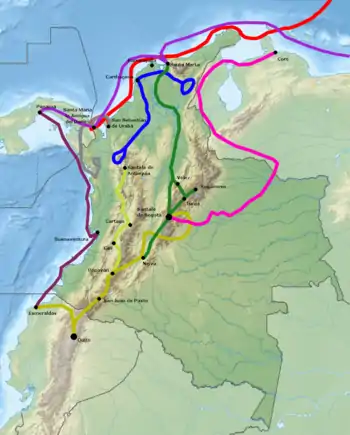Gonzalo Suárez Rendón
Gonzalo Suárez Rendón (c.1503, Málaga, Castile – 1590 (or 1583),[2] Tunja, New Kingdom of Granada) was a Spanish conquistador, known as the founder of the capital of Boyacá; Tunja. He took part in the Spanish conquest of the Muisca people led by Gonzalo Jiménez de Quesada, and later by his brother Hernán Pérez de Quesada. On August 6, 1539, he founded Tunja on the site of the former seat of the zaque (ruler) of the Hunza.[1]
Gonzalo Suárez Rendón | |
|---|---|
 Tomb of Suárez Rendón in the Cathedral of Tunja | |
| Born | c.1503 |
| Died | 1590 (or 1583) |
| Burial place | Cathedral of Tunja |
| Monuments | Casa Fundador Gonzalo Suárez Rendón |
| Nationality | Castilian |
| Occupation | Conquistador |
| Years active | 1536–1539 |
| Employer | Spanish Crown |
| Known for | Spanish conquest of the Muisca Founder of Tunja |
| Spouse(s) | Mencia de Figueroa y Godoy |
| Children | 2 sons: Nicolas & Miguel Suárez de Figueroa 2 daughters: Isabel de Godoy & María de la Trinidad Suárez de Figueroa |
| Parents |
|
| Relatives | Rodrigo Sabariego Suárez Rendón (brother) María Suárez Rendón (sister) |
| Signature | |
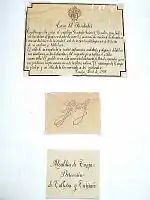 | |
| Notes | |
Gonzalo Suárez Rendón is mentioned in the work of uncertain authorship Epítome de la conquista del Nuevo Reino de Granada as "Suarex".[4]
Biography
Personal life
Gonzalo Suárez Rendón was born around 1503 in the Andalusian city of Málaga to Rodrigo Suárez Rendón de Jerez and Isabel Jiménez, or Ximénez, Suárez. He had one brother and one sister: Rodrigo Sabariego Suárez Rendon; and María Suárez Rendón. He married Mencia de Figueroa y Godoy in 1563 and the couple had four children: two sons and two daughters.[2][3]
American expeditions
The Suárez River, which the conquistadors followed to reach the Altiplano Cundiboyacense in early 1537, was named after Suárez Rendón when his horse drowned in it.[5]
Together with Hernán Pérez de Quesada and Gonzalo García Zorro, Suárez Rendón was one of the torturers of the last zipa, Sagipa.[6]
House in Tunja
The house built by Suárez Rendon, (Casa del Fundador Gonzalo Suárez Rendón), between August 7, 1539, the day after the foundation of Tunja, and 1570, still exists as the oldest colonial building in Tunja and the only remaining house of a colonial city founder in Latin America; it has been a museum since 1965.[7]
Gallery
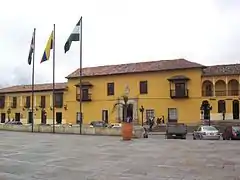 Casa Fundador Gonzalo Suárez Rendón on the Plaza Bolívar in Tunja
Casa Fundador Gonzalo Suárez Rendón on the Plaza Bolívar in Tunja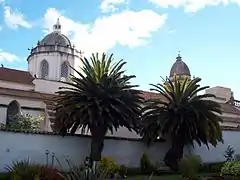 Casa Fundador Gonzalo Suárez Rendón
Casa Fundador Gonzalo Suárez Rendón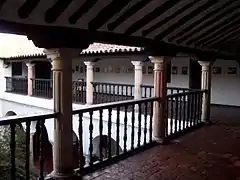 Casa Fundador Gonzalo Suárez Rendón
Casa Fundador Gonzalo Suárez Rendón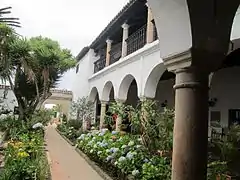 Casa Fundador Gonzalo Suárez Rendón
Casa Fundador Gonzalo Suárez Rendón
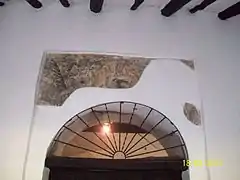 Casa
Casa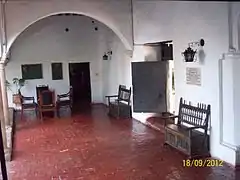 Casa
Casa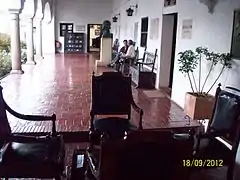 Casa
Casa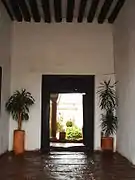 Casa
Casa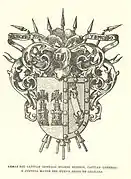 Coat of arms
Coat of arms
See also
References
- (in Spanish) List of conquistadors led by Gonzalo Jiménez de Quesada – Banco de la República
- (in Spanish) Biography Gonzalo Suárez Rendón
- (in Spanish) Gonzalo Suárez Rendón – Geni
- Epítome, p.82
- (in Spanish) Río Suárez foco de infección – El Tiempo
- Rodríguez Freyle, 1638, p.84
- (in Spanish) Casa Gonzalo Suárez Rendón
Bibliography
- Rodríguez Freyle, Juan, and Darío Achury Valenzuela. 1979 (1859) (1638). El Carnero – Conquista i descubrimiento del nuevo reino de Granada de las Indias Occidentales del mar oceano, i fundacion de la ciudad de Santa Fe de Bogota, 1–598. Fundacion Biblioteca Ayacuch. Accessed 2017-03-06.
- N, N. 1979 (1889) (1539). Epítome de la conquista del Nuevo Reino de Granada, 81–97. Banco de la República. Accessed 2017-03-01.
Further reading
- Acosta, Joaquín. 1848. Compendio histórico del descubrimiento y colonización de la Nueva Granada en el siglo décimo sexto – Historical overview of discovery and colonization of New Granada in the sixteenth century, 1–460. Beau Press. Accessed 2017-03-01.
- De Castellanos, Juan. 1857 (1589). Elegías de varones ilustres de Indias, 1–567. Accessed 2017-03-01.
- Fernández de Piedrahita, Lucas. 1676. VI.Historia general de las conquistas del Nuevo Reino de Granada. Accessed 2017-03-01.
- Jiménez de Quesada, Gonzalo. 1576. Memoria de los descubridores, que entraron conmigo a descubrir y conquistar el Reino de Granada. Accessed 2017-03-01.
- De Plaza, José Antonio. 1810. Memorias para la historia de la Nueva Granada desde su descubrimiento el 20 de julio de 1810, 1–464. Imprenta del Neo-Granadino. Accessed 2017-03-01.
- Simón, Pedro. 1892 (1626). Noticias historiales de las conquistas de Tierra Firme en las Indias occidentales (1882–92) vol.1–5. Accessed 2017-03-01.
